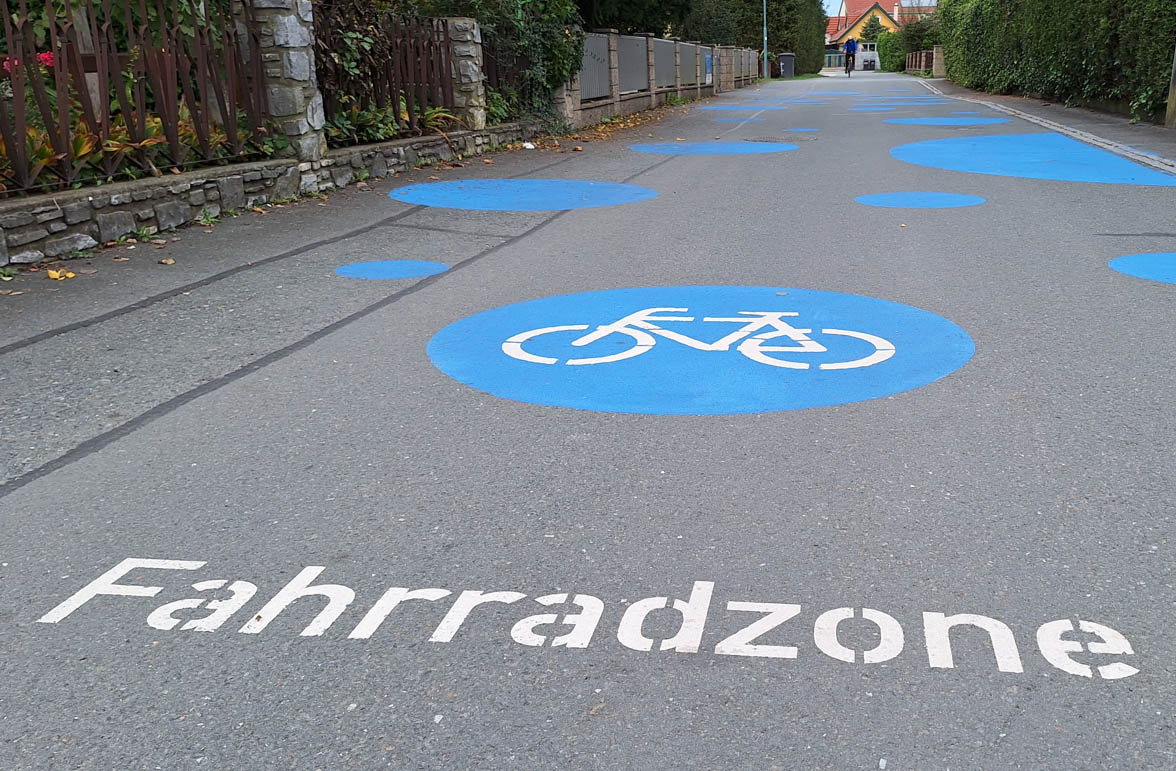Evaluation of Austria’s first bicycle zone

An experiment is taking place in the Styrian municipality of Fernitz-Mellach. Austria’s first bicycle zone is being tested and comprehensively evaluated here for 12 months. The difference to the German regulation, where bicycle zones have been in place since 2020: The term does not yet legally exist in Austria. The pilot test is being planned and monitored by Cycle Competence member verkehrplus, and we bring you the first results of the evaluation. The functionality and effect of the bicycle zone is to be investigated on a road network of around three kilometers in length; regulation boards and road markings at the entrances to the bicycle zone will inform all road users of the new rules of conduct.
What is a bicycle zone?
A bicycle zone is a network of interconnected bicycle lanes. It is a further development of the 30 km/h zone from the 1990s. The difference: motorists are not allowed to obstruct cyclists. Cyclists are allowed to ride side by side and, if necessary, motor vehicles must adjust their speed. Bicycle zones have been enshrined in German road traffic law as a regulatory instrument since 2020. To make cycling more attractive, Bremen created Germany’s first bicycle zone, in which bicycles have priority throughout the district.
Why a bike zone?
According to the Austrian StVO amendment of October 2022, Section 68 allows cyclists to ride side by side on roads with a speed limit of 30 km/h “provided that no one is endangered, the volume of traffic allows it and other road users are not prevented from overtaking”, with the exception of priority roads, among others. verkehrplus explains why the bicycle zone is still needed as follows: ‘The difference lies in perception, in perspective, in appreciation. While cycling side by side is approved, granted and permitted in the 30 km/h road, it is desired, required and “normal” in the cycle zone. Cycling becomes the system, not the exception! The bicycle becomes the yardstick – its speed determines the speed at which motor vehicles follow the bicycle. Cycle side by side without “pressure from behind” and without worrying about close overtaking maneuvers.
The bicycle zone raises the status of cyclists as fully-fledged road users on an equal footing with motor vehicle users. The “weaker” road users are thus “strengthened”. The bicycle zone transforms the existing secondary road network into an attractive, comprehensive and convenient cycling network that starts on the doorstep. And additionally, it prohibits the passage of motor vehicles from other locations.
The bicycle zone was implemented in accordance with the German Road Traffic Act (StVO) by designating several roads and road sections as contiguous bicycle lanes with the additional sign “Zone”. This procedure was legally examined and a legal opinion for the regulation as a bicycle road with the additional information “Zone” as an additional sign exists. The ordinance review by the Province of Styria is ongoing.
Evaluation results: Experiment successful?
The blue paint on the access roads to the bicycle zone had not yet dried when the phones were already ringing in the municipality. Some residents misunderstood the new regulation. Rumors such as: “We’re no longer allowed to drive our cars to our own houses!” and “Now cyclists have priority everywhere!” were doing the rounds. Further clarification was needed. The municipality further increased communication with additional information posters and events. The deputy mayor responsible and the planners in charge were on hand to answer questions. It quickly became clear that the bicycle zone itself is not a problem, but provides an ideal platform for discussing traffic on one’s own doorstep.
Survey result no. 1 from the online survey to evaluate the bicycle zone in the municipality of Fernitz-Mellach shows very high approval with 335 responses: 88% of respondents expect the introduction of the bicycle zone to improve the traffic situation. (verkehrplus, 2024)
Survey result no. 2 from the street survey to evaluate the bike zone shows a very high feeling of safety in the bike zone. 48% of survey-participants would let their child bike there alone, 45% only at certain times of the day or on weekends. Only 6% would not let children cycle in the cycle zone. (verkehrplus, 2024)
Cycling Competence Members in this article:
More articles with this member:
[crp]
Share this article:
Evaluation of Austria’s first bicycle zone
Share this article:

An experiment is taking place in the Styrian municipality of Fernitz-Mellach. Austria’s first bicycle zone is being tested and comprehensively evaluated here for 12 months. The difference to the German regulation, where bicycle zones have been in place since 2020: The term does not yet legally exist in Austria. The pilot test is being planned and monitored by Cycle Competence member verkehrplus, and we bring you the first results of the evaluation. The functionality and effect of the bicycle zone is to be investigated on a road network of around three kilometers in length; regulation boards and road markings at the entrances to the bicycle zone will inform all road users of the new rules of conduct.
What is a bicycle zone?
A bicycle zone is a network of interconnected bicycle lanes. It is a further development of the 30 km/h zone from the 1990s. The difference: motorists are not allowed to obstruct cyclists. Cyclists are allowed to ride side by side and, if necessary, motor vehicles must adjust their speed. Bicycle zones have been enshrined in German road traffic law as a regulatory instrument since 2020. To make cycling more attractive, Bremen created Germany’s first bicycle zone, in which bicycles have priority throughout the district.
Why a bike zone?
According to the Austrian StVO amendment of October 2022, Section 68 allows cyclists to ride side by side on roads with a speed limit of 30 km/h “provided that no one is endangered, the volume of traffic allows it and other road users are not prevented from overtaking”, with the exception of priority roads, among others. verkehrplus explains why the bicycle zone is still needed as follows: ‘The difference lies in perception, in perspective, in appreciation. While cycling side by side is approved, granted and permitted in the 30 km/h road, it is desired, required and “normal” in the cycle zone. Cycling becomes the system, not the exception! The bicycle becomes the yardstick – its speed determines the speed at which motor vehicles follow the bicycle. Cycle side by side without “pressure from behind” and without worrying about close overtaking maneuvers.
The bicycle zone raises the status of cyclists as fully-fledged road users on an equal footing with motor vehicle users. The “weaker” road users are thus “strengthened”. The bicycle zone transforms the existing secondary road network into an attractive, comprehensive and convenient cycling network that starts on the doorstep. And additionally, it prohibits the passage of motor vehicles from other locations.
The bicycle zone was implemented in accordance with the German Road Traffic Act (StVO) by designating several roads and road sections as contiguous bicycle lanes with the additional sign “Zone”. This procedure was legally examined and a legal opinion for the regulation as a bicycle road with the additional information “Zone” as an additional sign exists. The ordinance review by the Province of Styria is ongoing.
Evaluation results: Experiment successful?
The blue paint on the access roads to the bicycle zone had not yet dried when the phones were already ringing in the municipality. Some residents misunderstood the new regulation. Rumors such as: “We’re no longer allowed to drive our cars to our own houses!” and “Now cyclists have priority everywhere!” were doing the rounds. Further clarification was needed. The municipality further increased communication with additional information posters and events. The deputy mayor responsible and the planners in charge were on hand to answer questions. It quickly became clear that the bicycle zone itself is not a problem, but provides an ideal platform for discussing traffic on one’s own doorstep.
Survey result no. 1 from the online survey to evaluate the bicycle zone in the municipality of Fernitz-Mellach shows very high approval with 335 responses: 88% of respondents expect the introduction of the bicycle zone to improve the traffic situation. (verkehrplus, 2024)
Survey result no. 2 from the street survey to evaluate the bike zone shows a very high feeling of safety in the bike zone. 48% of survey-participants would let their child bike there alone, 45% only at certain times of the day or on weekends. Only 6% would not let children cycle in the cycle zone. (verkehrplus, 2024)
Cycling Competence Members in this article:
More articles with this member:
[crp]





